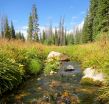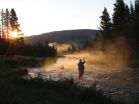(Press-News.org) All freshwater streams and rivers actually release carbon dioxide, but the source of those emissions has for years been unclear to scientists.
Now, researchers have shown that the greenhouse gas appears in streams by way of two different sources -- either as a direct pipeline for groundwater and carbon-rich soils, or from aquatic organisms releasing the gas through respiration and natural decay.
CO2's origins -- land or life -- depend largely on the size of the stream or river, according to a paper published Aug. 10 in Nature Geosciences. These findings shed light on the role freshwater rivers play in the global carbon cycle.
"This paper validates that in certain systems, a lot of the carbon dioxide is coming from terrestrial systems, but as you get to larger rivers, that connection to the land becomes less and less strong. This is the first broad study to show that," said co-author David Butman, a University of Washington assistant professor of environmental and forest sciences and of civil and environmental engineering.
The researchers found that smaller streams usually carry carbon dioxide that is produced by plants on land and then transferred to the water by way of soil and groundwater. That happens because at its headwaters, a small stream often is surrounded by trees and other plants that pull carbon out of the atmosphere and store or "sink" it in soils and biomass.
But in larger streams, most CO2 emissions are produced directly in the water itself. More plants and animals are present in larger rivers, and they use available oxygen and convert organic carbon to carbon dioxide through respiration.
Understanding how carbon dioxide ends up in streams and rivers will improve predictions of how changes to river systems affect the efficiency of terrestrial ecosystems at removing greenhouse gases from the atmosphere, researchers say.
"It is very important to know the sources of carbon dioxide in running waters as well as the processes controlling respiration and emissions if we are to understand what happens when the environment changes," said lead author Erin Hotchkiss, who completed the research while at Umeå University in Sweden.
Butman and Hotchkiss, along with other collaborators at Umeå University and the University of Wyoming, began working together about two years ago to see if they could pinpoint where the carbon dioxide measured in rivers and streams was coming from.
The researchers looked at long-term U.S. Geological Survey data from about 1,400 freshwater streams and rivers across the U.S., as well as data collected from more than 180 river monitoring sites. Their models showed that aquatic plants and animals produced about 30 percent of the carbon dioxide found in streams and rivers in the U.S. on average, and that number ranged from only 14 percent in the smallest streams to near 40 percent in large rivers.
The main takeaway, Butman said, is that rivers and streams don't all behave the same way with regard to putting out carbon dioxide. This study is one of the first attempts to identify the source of carbon in freshwater river systems at a very large scale, helping to further our understanding of the role streams and rivers play in the global carbon cycle.
"Figuring out how these streams fit into the larger carbon cycle is most important," he said.
The next step is to take the research beyond modeling and do actual broad-scale measurements of CO2 along entire networks of streams, Butman added.
INFORMATION:
Other co-authors are Robert O. Hall Jr. at the University of Wyoming; and Ryan Sponseller, Jonatan Klaminder, Hjalmar Laudon, Martin Rosvall and Jan Karlsson at Umeå University.
This research was funded by Kempestifelserna, a foundation in Sweden, with additional data and analysis support through Butman and the U.S. Geological Survey's LandCarbon Program.
For more information, contact Butman at dbutman@uw.edu or 206-685-0953.
Related paper: http://www.nature.com/ngeo/journal/vaop/ncurrent/full/ngeo2507.html END
For any computer, being able to manipulate information is essential, but for quantum computing, singling out one data location without influencing any of the surrounding locations is difficult. Now, a team of Penn State physicists has a method for addressing individual neutral atoms without changing surrounding atoms.
"There are a set of things that we have to have to do quantum computing," said David S. Weiss, professor of physics. "We are trying to step down that list and meet the various criteria. Addressability is one step."
Quantum computers are constructed and ...
Simply put, cancer is caused by mutations to genes within a cell that lead to abnormal cell growth. Finding out what causes that genetic mutation has been the holy grail of medical science for decades. Researchers at the Texas A&M Health Science Center Institute of Biosciences and Technology believe they may have found one of the reasons why these genes mutate and it all has to do with how stem cells talk to each other.
The landmark studies by Texas A&M researchers Fen Wang, Ph.D., and Wallace McKeehan, Ph.D., appear in the Journal of Biological Chemistry and are available ...
CAMBRIDGE, MA -- Chemists working in a variety of industries and fields typically go through a laborious process to measure and mix reagents for each reaction they perform. And many of the common reagents they use sit for months or years on shelves in laboratories, where they can react with oxygen and water in the atmosphere, rendering them useless.
In a paper published this week in Nature, researchers at MIT describe a technique that could help avoid this costly waste, and greatly reduce the number of steps a chemist must perform to prepare common compounds for use in ...
Male elephant seals compete fiercely for access to females during the breeding season, and their violent, bloody fights take a toll on both winners and losers. These battles are relatively rare, however, and a new study shows that the males avoid costly fights by learning the distinctive vocal calls of their rivals. When they recognize the call of another male, they know whether to attack or flee depending on the challenger's status in the dominance hierarchy.
Researchers from UC Santa Cruz have been studying the behavior of northern elephant seals at Año Nuevo ...
BOSTON - Researchers from Beth Israel Deaconess Medical Center (BIDMC) are homing in on the potential benefits of allowing patients access to the notes their clinicians write after a visit. An article published in the August edition of The Joint Commission Journal on Quality and Patient Safety suggests that this kind of patient engagement has the power to improve safety and quality of care.
The practice of sharing visit notes more readily began with the OpenNotes study in 2010. More than 100 primary care doctors at three hospitals invited 20,000 of their patients to ...
In debt and don't know what to do? Conventional economic wisdom says to pay off high-interest loans first. Yet according to a new study in the Journal of Marketing Research, paying off your smallest debts first can provide the motivation you need to successfully pay off even the most burdensome debts.
"Winning what are known as 'small victories' by paying off small debts first can give consumers a real boost in eventually paying off all their debts," write the authors of the study, Alexander L. Brown (Texas A&M University) and Joanna N. Lahey (Texas A&M University). "The ...
Legos, the popular toy bricks, may be great for stimulating creativity in little kids. But when it comes to adults, things might be a little different. According to a new study in the Journal of Marketing Research, when adults are given a set of Legos to solve a well-defined problem, their creativity may suffer when tackling subsequent tasks.
"There are a lot of studies that explore what enhances creativity. Ours is one of the few that considers ways in which creativity may be undermined," write the authors of the study, C. Page Moreau (University of Wisconsin) and Marit ...
Attention all you would-be forecasters out there. Do you want people to think you know the future? Then predict with a high degree of certainty that something will happen. According to a new study in the Journal of Marketing Research, people trust a forecaster more when she predicts that something is more likely to occur.
"When a forecaster predicts that something has a high likelihood of happening, consumers infer that the forecaster is more confident in her prediction, that she is basing the prediction on more in-depth analysis, and that she is more trustworthy," write ...
New companies are often successful because they are innovative. In search of new capital, these companies often go public. But does going public affect a company's ability to remain creative and at the cutting edge--the very qualities that allowed it be successful in the first place? A new study in the Journal of Marketing Research says yes. According to the study, when companies go public, they actually innovate more--but their innovations are far more conservative and less groundbreaking than before.
"Going public is a mixed bag for firms when it comes to innovation. ...
Exporting is a popular way to enter an international market. But just how are export decisions made? In a rapidly changing economic environment, can exporting companies rely on improvisation? Or should they commit to carefully thought out and executed plans? According to a new study in the Journal of Marketing Research, companies need to do both, to plan as well as improvise, as there is no one "best way" for export managers to make decisions.
"That both planning and improvisation are needed may come as a surprise. Historically, observers have viewed planning and improvisation ...


